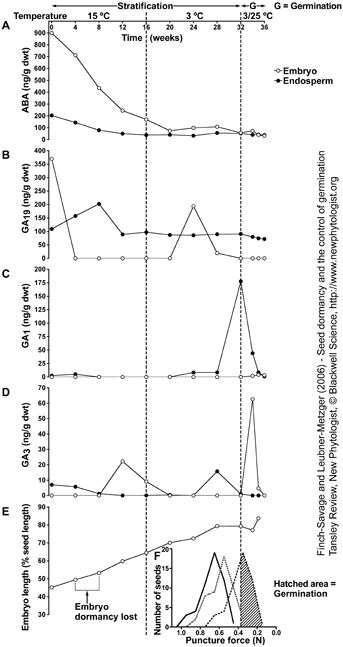Tansley Review - New Phytologist 171: 501-523 (2006)
|
Seed dormancy and the control of germination
|
William E. Finch-Savage (1), Gerhard Leubner-Metzger (2)
|
(1) Warwick HRI, Warwick University, Wellesbourne, Warwick CV35 9EF, United Kingdom, Web: 'Seed Science Group' http://www2.warwick.ac.uk/fac/sci/hri2/research/seedscience/
(2) Institut für Biologie II (Botanik/Pflanzenphysiologie), Albert-Ludwigs-Universität Freiburg,
Schänzlestr. 1, D-79104 Freiburg i. Br., Germany, Web: 'The Seed Biology Place' http://www.seedbiology.de
Received February 23, 2006; accepted March 27, 2006
|
 |
 |
Figure 6. Dormancy release during stratification in Fraxinus excelsior includes endosperm weakening that is mediated by gibberellins. The stratification treatment was 16 weeks at 15 °C followed by 16 weeks at 3 °C. Seeds were then transferred to dormancy breaking/germination conditions of 16h at 3 °C followed by 8h 25 °C. (A-D) Original endogenous hormone data (ABA, GA19, GA1 and GA3 respectively) sampled and measured by methods described in Blake et al. (2002). Closed circles, endosperm; Open circles, embryo. (B, C, D) The inactive precursor of GA1, GA19 accumulates in the endosperm during stratification, but significant GA1 does not occur for several weeks after the start of cold treatment when ABA concentration is minimal. GA1 is not present in the embryo, but GA3 accumulates later in the embryo coincident with radicle extension growth leading to germination. (E) Embryo growth within the seed. Initially the embryo will not grow when excised from the seed, but this physiological dormancy is progressively lost in the first half of the warm period as endogenous ABA concentration (A) declines. The embryo will then grow to the full length of the endosperm cavity and will continue to grow if excised from the seed coat (E). However, germination of the whole seed will not reach completion without cold. If provided only with a cold treatment the embryo remains dormant and will not grow. (F) The distribution of forces in the population required to puncture the endosperm/seed coat layer which constrains the embryo (Finch-Savage & Clay, 1997). Radicle emergence was possible as puncture force declined below 0.4 N. Solid dark line, dormant seed; dotted gray line, stratified seed; dotted dark line, hypothetical data following continued exposure to the dormancy breaking/germination conditions; hatched area designates germination. Data in E and F are from Finch-Savage and Clay (1997).
|
|
| |

|
|
Webdesign Gerhard Leubner 2000
Best viewed with browser version 4 and 800x600 pixel
This page was last updated on
15 July, 2006
|
|
